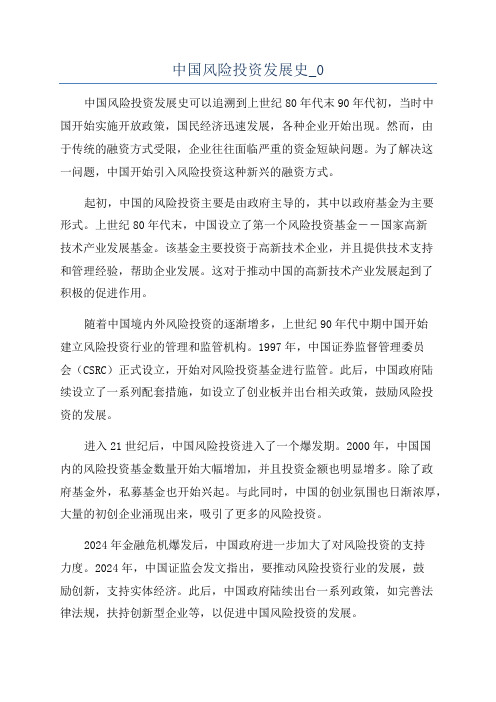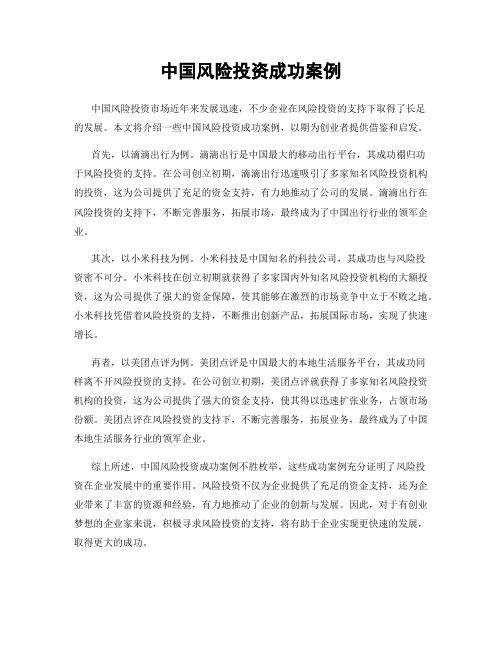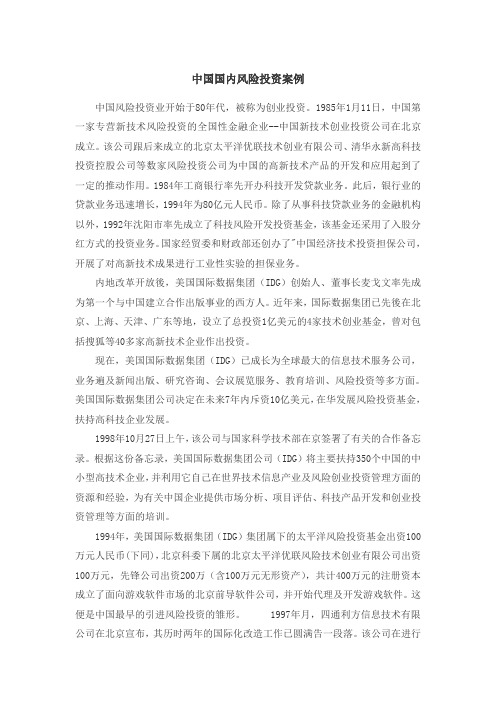中国风险投资发展史
中国风险投资简介资料

经验丰富且稳 定的专业投资 团队 品牌影响力
良好的历史投 资业绩
特点
在China Venture2011年最佳风投企 业评比中入围前20名 中国技术创业协会科技创业投资 奖——科技投资机构活跃奖 “CVAwards 2011年绿色创业投资 机构排行榜”第一名
严格有效的投 资策略 广泛的项目来 源
中国民主建国 会的独特背景 和资源
孙集平(高级副总裁)
STRICTLY PRIVATE AND CONFIDENTIAL
— 经济学硕士,先后任职于大型央企和国企高管、中国风险投资有 限公司高级副总裁,具有20余年企业管理经验和8年风险投资经验。 — 在项目源挖掘、政府关系协调谈判、尽职调查、项目管理与增值 服务等方面具有丰富经验,发起设立了深圳华澳基金并参与和负责投资决策, 拥有丰富的早期项目投资经验,属于节能环保领域内的资深投资专家。
•
广泛的项目来源
— 中国风投依托自身的品牌、特殊行业地位和丰富的人脉资源,通过民建系统、中 国 环保产业协会、公司电子商务平台、科技园区项目、多个地区的科委和金融办、科 研院所、政府机构等发掘优秀项目。
STRICTLY PRIVATE AND CONFIDENTIAL
•
严格有效的投资策略
— 2001年至今,核心团队通过研究和实践,已形成了一套成熟、稳定的投资策略。
3
高级管理层
李爱民(高级副总裁)
—李爱民,中国风险投资有限公司高级副总裁。 李先生毕业于中国 科技大,曾以访问学者身份到美国DUKE大学进修创业投资,后在科技部条财司 担任重要职务,在2005年-2009年期间担任中国驻旧金山总领馆科技领事。 —李先生活跃于创业投资领域——是中国创业投资早期发展的主要宣 讲者之一,是政府引导基金和“三板”的早期推动者之一,同时又是北京创业 投资协会的发起人之一。 李先生是同时兼备学者、政府官员和实际投资经验 履历于一身的业内知名专家。
风险投资史

风险投资史
风险投资史从美国的开山鼻祖开始说起,1890年,美国第一家风险投资公司,“摩根大通有限公司”(后来的“摩根大通集团”)在纽约诞生。
1930年,美国雷曼兄弟将风险投资正式作为一种新的融资模式引入市场。
1976年,风险投资成为一种投资手段,由著名的“沃伦·巴菲特”主导,美国各大投资公司结成了独立的投资公司,开始小规模机构化。
1980年,中国首家风险投资公司成立,标志着中国风险投资的开山之作。
进入21世纪以后,风险投资行业进入了快速成长阶段,全球金融行业风险投资投资者也不断壮大,从传统银行、私募资金、保险公司到信托公司,再到投资基金、多项目投资方案,以及家族办公室等不同模式的风险投资者形成了复杂多样的格局。
同时,风险投资相关法律法规制度也在不断完善,为风险投资行业发展提供了支撑。
今天的风险投资行业,越来越深入地发掘人们的创新思维,投资者不仅仅看重投资回报,还越来越强调投资公司帮助其创业者发展的重要性。
风险投资新形势的到来,让中国的创新产业发展速度更加迅猛,风险投资新模式为企业家及市场创造更多新的发展机会,改变传统投资模式,为中国经济发展注入新动力。
中国风险投资发展史_0

中国风险投资发展史_0中国风险投资发展史可以追溯到上世纪80年代末90年代初,当时中国开始实施开放政策,国民经济迅速发展,各种企业开始出现。
然而,由于传统的融资方式受限,企业往往面临严重的资金短缺问题。
为了解决这一问题,中国开始引入风险投资这种新兴的融资方式。
起初,中国的风险投资主要是由政府主导的,其中以政府基金为主要形式。
上世纪80年代末,中国设立了第一个风险投资基金--国家高新技术产业发展基金。
该基金主要投资于高新技术企业,并且提供技术支持和管理经验,帮助企业发展。
这对于推动中国的高新技术产业发展起到了积极的促进作用。
随着中国境内外风险投资的逐渐增多,上世纪90年代中期中国开始建立风险投资行业的管理和监管机构。
1997年,中国证券监督管理委员会(CSRC)正式设立,开始对风险投资基金进行监管。
此后,中国政府陆续设立了一系列配套措施,如设立了创业板并出台相关政策,鼓励风险投资的发展。
进入21世纪后,中国风险投资进入了一个爆发期。
2000年,中国国内的风险投资基金数量开始大幅增加,并且投资金额也明显增多。
除了政府基金外,私募基金也开始兴起。
与此同时,中国的创业氛围也日渐浓厚,大量的初创企业涌现出来,吸引了更多的风险投资。
2024年金融危机爆发后,中国政府进一步加大了对风险投资的支持力度。
2024年,中国证监会发文指出,要推动风险投资行业的发展,鼓励创新,支持实体经济。
此后,中国政府陆续出台一系列政策,如完善法律法规,扶持创新型企业等,以促进中国风险投资的发展。
总而言之,中国风险投资的发展经历了数十年的探索与积累,并且得到了中国政府的大力支持。
目前,中国风险投资已经成为推动中国经济发展和创新的重要力量,为中国经济的转型升级提供了源源不断的资金支持,同时也为中国企业提供了更多的发展机会和平台。
未来,随着中国经济的继续发展,风险投资行业也将继续迎来更多的机遇和挑战。
中国风险投资发展历程

中国风险投资发展历程
中国风险投资发展历程可以追溯到上世纪80年代末90年代初。
当时,中国的资本市场和金融体系都相对薄弱,风险投资在中国还处于起步阶段。
1992年,中国政府开始实行改革开放政策,在吸引外资和培
育本土企业发展方面做出了积极努力。
同时,国有企业改革也开始推进,一些企业开始转型、改革或私有化,为风险投资提供了机会。
1995年,中国证券监督管理委员会成立,标志着中国资本市
场的发展迈出了重要的一步。
这为风险投资提供了更好的环境和机会。
然而,由于中国缺乏风险投资的经验和体系,风险投资在最初的几年里进展缓慢。
这也导致了很多创业企业只能依靠传统的融资方式,如银行贷款或个人资金。
2000年以后,随着中国经济的高速增长和市场环境的改善,
风险投资逐渐兴起。
外资风险投资机构纷纷进入中国市场,同时中国本土的风险投资机构也开始崛起。
2009年,中国政府出台了一系列支持创业和创新的政策,进
一步推动了风险投资的发展。
特别是在科技创新领域,政府加大对科技企业的支持力度,鼓励风险投资机构投资科技创业公司。
近年来,随着中国经济增速的放缓,风险投资领域也面临一些挑战。
不过,相对较低的风险投资回报率和风险相对较高的土壤仍然吸引着一些投资者。
总体而言,中国风险投资的发展经历了从无到有,从小到大的过程。
在政策支持、资本市场和金融体系的完善以及投资者意识的提升等多方面推动下,中国风险投资的未来发展潜力仍然巨大。
风险投资发展历程

风险投资发展历程风险投资是一种为高风险高回报的初创企业提供资金和支持的投资活动。
随着时间的推移,风险投资行业经历了多个阶段的发展和变化。
大约在二十世纪五六十年代,风险投资开始兴起。
当时,投资者通常是家族企业或富裕个人,他们寻求机会来投资创新的企业,并分享其成功的回报。
这个时期的投资者主要关注于工程和生命科学领域的初创企业。
在七八十年代,风险投资逐渐进入了金融市场的主流。
这一时期,一些大型银行和金融机构成立了风险投资部门,开始投资各个行业的初创企业。
这一时期还出现了一些成功的风险投资公司,如凯雷投资公司和新企业协会。
进入九十年代,随着互联网的兴起,风险投资进入了一个全新的发展阶段。
大量的风险投资资金涌入互联网行业,支持了众多的互联网初创企业。
这个时期被称为“点com时代”,许多企业在短时间内获得了巨大的估值,但也有很多企业最终破产。
从2000年代开始,风险投资进入了一个相对低迷的时期。
由于互联网泡沫的破灭,许多投资者对风险投资持谨慎态度。
然而,随着移动互联网、人工智能和区块链等技术的兴起,风险投资很快又回到了增长轨道。
越来越多的创新型初创企业涌现出来,吸引了大量的风险资金。
如今,风险投资已经成为全球范围内的重要投资活动。
风险投资公司和天使投资人在全球范围内寻找有潜力的初创企业,并提供资金、经验和资源支持其成长。
同时,政府和其他机构也推出了各种政策和计划,以促进创业和创新,进一步推动了风险投资的发展。
总的来说,风险投资经历了从家族企业到金融机构的发展变革,从工程和生命科学到互联网和科技的领域扩展,不断适应时代的变化和需求。
随着科技的进步和全球创业热潮的兴起,风险投资在未来仍然有着广阔的发展前景。
中国风险投资成功案例

中国风险投资成功案例中国风险投资市场近年来发展迅速,不少企业在风险投资的支持下取得了长足的发展。
本文将介绍一些中国风险投资成功案例,以期为创业者提供借鉴和启发。
首先,以滴滴出行为例。
滴滴出行是中国最大的移动出行平台,其成功禤归功于风险投资的支持。
在公司创立初期,滴滴出行迅速吸引了多家知名风险投资机构的投资,这为公司提供了充足的资金支持,有力地推动了公司的发展。
滴滴出行在风险投资的支持下,不断完善服务,拓展市场,最终成为了中国出行行业的领军企业。
其次,以小米科技为例。
小米科技是中国知名的科技公司,其成功也与风险投资密不可分。
小米科技在创立初期就获得了多家国内外知名风险投资机构的大额投资,这为公司提供了强大的资金保障,使其能够在激烈的市场竞争中立于不败之地。
小米科技凭借着风险投资的支持,不断推出创新产品,拓展国际市场,实现了快速增长。
再者,以美团点评为例。
美团点评是中国最大的本地生活服务平台,其成功同样离不开风险投资的支持。
在公司创立初期,美团点评就获得了多家知名风险投资机构的投资,这为公司提供了强大的资金支持,使其得以迅速扩张业务,占领市场份额。
美团点评在风险投资的支持下,不断完善服务,拓展业务,最终成为了中国本地生活服务行业的领军企业。
综上所述,中国风险投资成功案例不胜枚举,这些成功案例充分证明了风险投资在企业发展中的重要作用。
风险投资不仅为企业提供了充足的资金支持,还为企业带来了丰富的资源和经验,有力地推动了企业的创新与发展。
因此,对于有创业梦想的企业家来说,积极寻求风险投资的支持,将有助于企业实现更快速的发展,取得更大的成功。
中国国内风险投资案例

中国国内风险投资案例中国风险投资业开始于80年代,被称为创业投资。
1985年1月11日,中国第一家专营新技术风险投资的全国性金融企业--中国新技术创业投资公司在北京成立。
该公司跟后来成立的北京太平洋优联技术创业有限公司、清华永新高科技投资控股公司等数家风险投资公司为中国的高新技术产品的开发和应用起到了一定的推动作用。
1984年工商银行率先开办科技开发贷款业务。
此后,银行业的贷款业务迅速增长,1994年为80亿元人民币。
除了从事科技贷款业务的金融机构以外,1992年沈阳市率先成立了科技风险开发投资基金,该基金还采用了入股分红方式的投资业务。
国家经贸委和财政部还创办了"中国经济技术投资担保公司,开展了对高新技术成果进行工业性实验的担保业务。
内地改革开放後,美国国际数据集团(IDG)创始人、董事长麦戈文率先成为第一个与中国建立合作出版事业的西方人。
近年来,国际数据集团已先後在北京、上海、天津、广东等地,设立了总投资1亿美元的4家技术创业基金,曾对包括搜狐等40多家高新技术企业作出投资。
现在,美国国际数据集团(IDG)已成长为全球最大的信息技术服务公司,业务遍及新闻出版、研究咨询、会议展览服务、教育培训、风险投资等多方面。
美国国际数据集团公司决定在未来7年内斥资10亿美元,在华发展风险投资基金,扶持高科技企业发展。
1998年10月27日上午,该公司与国家科学技术部在京签署了有关的合作备忘录。
根据这份备忘录,美国国际数据集团公司(IDG)将主要扶持350个中国的中小型高技术企业,并利用它自己在世界技术信息产业及风险创业投资管理方面的资源和经验,为有关中国企业提供市场分析、项目评估、科技产品开发和创业投资管理等方面的培训。
1994年,美国国际数据集团(IDG)集团属下的太平洋风险投资基金出资100万元人民币(下同),北京科委下属的北京太平洋优联风险技术创业有限公司出资100万元,先锋公司出资200万(含100万元无形资产),共计400万元的注册资本成立了面向游戏软件市场的北京前导软件公司,并开始代理及开发游戏软件。
中国风险投资:过去,现在和将来【外文翻译】

外文翻译原文:Venture capital in China: Past, present, and future China represents one of the fastest growing markets for venture capital investing in the world. In 2005 alone it was estimated that $1.17 billion was raised by venture capital firms to invest in China, up from $325 million in 2002 (Balfour, 2006). However, there are significant challenges to such venture investing in a transition economy where private enterprises were only recently given legal sanction. In China, venture capitalists find that they play more roles and are faced with a broader set of tasks than is typical, further complicating their work (Liu, Zhang, & Hu, 2006). These challenges among others have led John Mumford, the founding partner of Crosspoint Venture Partners to p redict: “Most if not all early stage venture capital being invested in...China will be lost” (Aragon, 2006: 1).That there would be such challenges for private equity investing in China is not to be unexpected. Investment in new projects and technologies in mature economies is a challenging endeavor even for established firms, which often fail to create lasting growth with their investments (Jensen, 1993). Investments in start-up entrepreneurial ventures in mature economies by venture capitalists are similarly challenging (Christensen, 2000). Venture capitalists in such economies have found ways to reduce the risk associated with new venture investment by reducing the nonsystematic risk involved in investing (Christensen, 2000). They do this though careful due diligence, providing management and personnel assistance, careful monitoring of the investment, and well-planned exit strategies. However, in mature economies such as in North America and Western Europe, the rule of law is well established and venture capitalists are able to carry out these activities to reduce nonsystematic risk relatively easily (Bruton, Ahlstrom, & Yeh, 2004). Thus, the institutional stability and predictability helps to create an environment that can help to control the higher risk climate of private equity and venture capital investing (Bruton et al., 2004). In a developing economy like that of China, institutional stability is still not achieved,such factors are not present. Developing economies are often characterized by institutions and that are underdeveloped, property rights that are ill-defined, enforcement that is nonexistent and little legitimacy for private firms (Le, Venkatesh, & Nguyen, 2006) and China is no exception to this (McGregor, 2005). The result is heightened risk and difficulty in collecting accurate data and monitoring investments.The venture capital industry in every country is shaped in part by its institutional context (Çetin damar, 2003). The supply-side institutional variables affecting the venture capital industry include the level of economic development, existence of national systems of innovation, level of entrepreneurship, labor practices, corporate ownership regulations, educational achievement, the legal system, and business cultures. Crucial demand-side variables include issues such whether new firms are commercializing new business opportunities capable of justifying high-risk equity investments. Since the industry is so dependent on the national (and, in some cases, regional) institutional environment a range of national evolutionary trajectories is found in the venture capital industry around the world (Çetin damar, 2003). Additionally, there are institutional forces that both encourage and discourage the development of venture capital in a country. The result is that a venture capital industry will evolve in a punctuated fashion in fits and starts rather than monotonically. Thus, China’s venture capital industry may share some characteristics of other country’s venture capital industries, but also h as its own characteristics idiosyncratic to its institutional environment.The institutional context in China that produces the unique differences includes the lack of intellectual property protection and the fact that assets can be seized and held with little recourse to the owners (Peng, 2000). China, and most emerging economies, also lack active markets for corporate control (Peng, Luo, & Sun, 1999) and established public equity markets by which investors can exit their investments (Bruton & Ahlstrom, 2003). This lack of property rights and (an enforceable) rule of law add to the complexity of the venture capital process (Bruton & Ahlstrom, 2003; Wright et al., 2004). These unique characteristics however have not prevented China from creating a rapidly growing market for venture capital. Local business practicesand traditions provide special challenges (Meyer, 2006). This article will examine how venture capitalists meet these challenges and work to control the considerable risk associated with financing new firms in China’s developing economy. The article concludes with a discussion of future prospects for research and practice of venture capital in China.While there has been a boom in venture capital in China in recent years, the understanding of the industry remains fragmented without a clear understanding of how it differs from that in the mature economies of North America. As a result, we extend the work of Ahlstrom, Yeh, and Bruton (2006) to report an exploratory examination of venture capital in China based on a grounded theory approach to data collection and analysis. Specifically, the research draws on interviews with venture capitalists currently active in China in order to identify a framework by which venture capital operates in China operates and how this compares and contrasts with that of North America. Specifically, five important aspects of venture capital in China will be examined: (1) the selection process for prospective firms, (2) monitoring the firm, (3) value-added activities provided to the funded firm, and (4) investment exit. Fifth and finally, the role that venture capitalists play in helping to formalize the often informal nature of business in China (Peng & Zhou, 2005)will be briefly appraised. This and other implications for practice and research on venture in China plus a prospective on the future direction of research in this important domain will be considered.Venture capital in ChinaSeveral key differences in venture capital in China from that in North America have been identified by previous research, including the meaning of the term. In North America venture capital is generally understood to mean privately transacted, early stage equity investments typically in small firms with high growth potential. This can include seed, expansion, and pre-offering rounds of financing. In exchange for financing, venture capital investors receive significant ownership claims and some control over top management. They are active investors, usually appointing directors and exercising strict oversight during the investment period. Venture capitalists bring legitimacy and credibility to their funded firms, supplying experienced managementand sometimes providing key contacts in the government and other firms. The term private equity is used for latter stage mezzanine arrangements, buyouts, and turnaround investments. In the west the two terms, venture capital and private equity, have very different implications (Wright & Robbie, 1998). In emerging economies like China the two terms are often used interchangeably. To avoid confusion, this paper distinguishes venture capital from the broader concept of private equity and later stage investments.Another difference is that in North America the predominant format for venture capital is limited partnerships. The money for these limited partnerships comes from wealthy individuals, corporations, pension funds, foundations, and endowments. The general or managing partners are the professional venture capitalists, whereas the investors are passive limited partners. The typical fund operates for a set number of years (usually about seven with the potential to extend a few years) and then is terminated with funds returned to the investors. Normally, a venture capital firm manages more than one fund; while one fund is usually fully invested, another one is being invested, and a third is in the process of being raised. However, in China such funds are the exception and not the rule. The funds in China are more typically corporate funds associated with banks or corporations. We do not limit our review here to limited partnerships or bank/corporate venture capital firms, but such differences should be recognized as we examine the domain.Evolution of venture capital in ChinaStarting in the late 1970s, the Chinese government began relaxing its tight grip on the economy and private enterprise and investment proliferated. Starting from close to zero in 1979, the number of private enterprises passed the one million mark by the end of the twentieth century. Private and foreign investment helped to make the Chinese economy consistently one of the fastest growing in the world since 1979 (Lieberthal & Lieberthal, 2003). However, China still lacks many standard financing mechanisms for business, such as efficient equity markets and debt financing for smaller firms (Ahlstrom, Bruton, & Chan, 2000). As a result of these factors there are tremendous opportunities for venture capital in China as well as a number ofchallenges (Ahlstrom & Bruton, 2006).The first international venture capital firms entered China in the early 1980s. The impetus for the development of the Chinese venture capital industry was government policy; in China the government still has a dominant role in the economy. In 1984, the National Research Center of Science and Technology for Development suggested that China establish a venture capital system to promote high technology (White, Gao, &Zhang, 2005). Local governments in China encouraged and sometimes sponsored venture funds to invest in state owned enterprises to bring them up to a world standard for productivity and quality. One early such company was China New Technology Venture Investment, founded in 1985. Some were established firms, and others were founded solely to invest in China firms, particularly established state owned enterprises (Bruton, Dattani, Fung, Chow, & Ahlstrom, 1999).In the mid-1980s, venture capital in China was limited primarily to infrastructure and property investments; new hotels and tourist facilities were especially popular (Lau, 1999).Many of these early investments fared rather poorly over time, and private equity professionals’ interest waned (Lau, 1999). By the late 1980s, however, there was renewed interest in the China market. The government still desired such investments and China’s steady economic growth encouraged venture capital investment. However, the goals of the government and venture investors were in conflict. The central government wanted high tech and infrastructure investment, while at the time, investors preferred to focus on lower technology industries with lower risk (Ahlstrom, 1990; Lau, 1999). As a result, there were few venture capital investments in high tech startups.To illustrate this situation, the Shenzhen Special Economic Zone adjacent to HongKong was established with the goal of attracting venture capital seed money and high tech start-ups. Those early efforts were largely unsuccessful as the sums invested did not come close to the amounts needed, and what ventures were funded focused principally on property development and tourism that produced little or no return to many investors (Ahlstrom, 1990; Bruton et al., 1999). Since those early failures the industry has continued to evolve. The early 1990s saw a proliferation of venturecapital firms backed by state and local government. Because of the lack of experience among the government officials and the entrepreneurs, these efforts usually failed as well (Oster, 2001). To increase the professionalism of the industry the Chinese Venture Capital Association was inaugurated in 2002 and it has experienced extensive growth in the years since.Venture capital in China todayThe proliferation of forms and formats for venture capital firms in China can be seen as a large-scale experiment in which there is a search for the format that will be most effective in China’s transition economy. Today, are four distinct types of venture capital firms operate in China: (1) foreign firms, (2) government firms, (3) university firms, and (4) corporate firms,(White et al., 2005).1 Each of the different types of venture capital firms has experienced some successes and some difficulties, though foreign venture capital firms are most active. Today the venture capital industry in China is rapidly growing with an estimated total of $4.8 billion of funds in the country. Another $4.07 billion was raised in 2005 worldwide to invest in China (Areddy, 2006). In part this growth in funds can be traced to the fact that United States venture capital firms had raised large amounts of capital but the opportunities to invest those funds in the United States were limited after the Internet crash. For example, in 2004 it was estimated by the research firm VentureOne that there were $64 billion worth of funds which were committed in the United States but the utilized investment was only $20 billion per year (Rivlin, 2004). Thus, even if no new funds were raised—a very unlikely event—there would still be 3 1/2 years of funds raised but yet to be invested. The result was the funds began looking for alternative domains to invest. At the same time a number of firms active in Asia for a number of years such as The Caryle Group, H&Q Asia Pacific, Newbridge Partners, and Warbridge Pincus were having great success across Asia in areas such as China specific portals and search engines. As a result the “China story” has been largely bought by investors with many practitioners arguing that “every serious ... venture capital firm needs a China strategy” (Maschek, 2005). Today is there is strong pressure on foreign venture capital firms to have part of their portfolio invested in China, and encouragement from Beijing to furtherdevelop the smaller and less active domestic venture capital sector (Liu et al., 2006).Recently, it was estimated that there were about 250 international venture capital and private equity firms in China and a similar number of domestic venture capitalists (Liu et al., 2006). Local venture capitalists reckon that foreign venture capital firms represented about eight of the top ten venture investors in China. The foreign firms may be independent (organized as limited partnerships) or they may be captive (owned by a bank or other financial institution). The number of foreign venture capital firms is expected to continue its steady increase as venture capital firms continue to move into the China market (Liu et al., 2006). A side effect of the growing level of investment has produced a situation where there is a relatively large amount of money chasing relatively few quality deals. This has produced a setting where valuations for funded firms in China have climbed rather rapidly in spite of skepticism about their worth and very mixed fund performance (Foote, 2005).Source: David Ahlstrom, Garry D. Bruton, Kuang S. Yeh, 2007. “Venture capital in China: Past, present, and future”.Asia Pacific J Manage,February,pp.247-268.译文:中国风险投资:过去,现在和将来中国代表了在世界资本市场上增长最快的风险投资之一。
- 1、下载文档前请自行甄别文档内容的完整性,平台不提供额外的编辑、内容补充、找答案等附加服务。
- 2、"仅部分预览"的文档,不可在线预览部分如存在完整性等问题,可反馈申请退款(可完整预览的文档不适用该条件!)。
- 3、如文档侵犯您的权益,请联系客服反馈,我们会尽快为您处理(人工客服工作时间:9:00-18:30)。
中国风险投资发展史1984年11月,国家科委的几个年轻干部向中央有关部门呈报《对成立科学技术风险投资公司可行性研究的建议》的报告,该报告力陈现行管理体制的严重弊病在于科技研究的开发成果不能最大限度地转化为现实生产力,产生经济效益。
报告建议,成立风险投资公司可以克服现行科研经费管理的弊端,为科技产业化提供资本支持。
1985年3月,《中共中央关于科学技术体制改革的决定》提出“对于变化迅速、风险较大的高技术开发工作,可以设立创业投资给以支持”。
这是中国首次提出以风险投资的方式支持高科技产业的开发,为中国风险投资业的发展提供了政策上的依据和有利的保证。
1985年9月,以国家科委和中国人民银行为依托,国务院正式批准成立了我国第一家官方性的风险投资公司——“中国新技术创业投资公司”,注册资本金2700万元。
通过投资、贷款、租赁、财务担保和咨询等方式为高新技术风险企业的发展提供支持。
1998年6月22日,中国人民银行责令其停业关闭。
1986年颁布的《金融信托投资机构管理暂行规定》和1987年颁布的《中国人民银行关于审批金融机构若干问题的通知》,全国性的投资公司的设立由中国人民银行总行审核,报国务院审批;省级风险投资公司的设立有中国人民银行省级分行审核,报人民银行总行批准。
1993年《中国人民银行关于严格金融机构审批的通知》对核准制进一步强化。
(民间资本基本被排斥在外)1986年,国家科委在《科学技术白皮书》(1986年经国务院批准,国家科委(后改称科技部)决定公开发布《中国科学技术政策指南》(第1号)。
这是中国第一次以政府部门的名义出版的科学技术白皮书,公布党和国家在科学技术方面制定的政策)中首次提到了发展风险投资事业的战略方针。
此后一段时间内,又有中国招商技术有限公司、江苏省高新技术风险投资公司(1992年)、广州技术创业公司等一批探索性的风险公司问世。
但受特定环境的影响,这些机构并没有按设立时的发展计划运作起来。
1987年,以各个高新技术开发区为后盾,以促进高新技术成果的商品化、产业化和国际化为目的的高新技术企业“孵化器”——创业中心,开始在各地陆续设立,如武汉创业中心(1987年)、成都创业中心(1989年11月25日)、上海创业中心等,初步开创了中国科技风险投资机构成功运作的良好局面。
可以说,创业中心是中国科技投资业的先行者和实践者,为风险投资业在中国的兴起和发展开辟了道路。
1987年,国家经委和财政部创办“中国经济技术投资担保公司”,进行投资、融资和担保。
1988年5月,国务院正式批准以中关村电子一条街为基础建立北京新技术产业开发试验区。
我国第一个高新技术产业开发区诞生了。
8月,中国国家高新技术产业化发展计划-火炬计划开始实施,创办高新技术产业开发区和高新技术创业服务中心被明确列入火炬计划的重要内容。
在火炬计划的推动下,各地纷纷结合当地特点和条件,积极创办高新技术产业开发区。
1989年6月,经国务院、外经贸部批准,由香港招商局集团、国家科委和国防科工委联合发起成立“中国科招高技术有限公司”。
该公司主要负责国家高技术计划(863、火炬等)成果的产业化投资,同时也是中国第一家中外合资的创业投资公司。
19901991年以后,进入另外一个阶段,国家对建立中国特色的创业投资机之进行了研究和规划,主要是由科技部牵头,会同国务院相关部委,会同有关专家,进行了研究。
1991年国务院在《国家高新技术产业开发区若干政策的暂行规定》中指出:“有关部门可以在高新技术产业开发区建立风险投资基金,用于风险较大的高新技术产业开发。
条件成熟的高新技术开发区可创办风险投资公司。
”这标志着风险投资在我国已受到政府的高度重视。
1991年,国家科委、财政部和中国工商银行联合发起成立“科技风险开发事业中心”。
1991年,广州市政府创建了“高新技术产业创业投资补偿基金”。
南山基金、淄博基金都是1991年到1997年这一阶段成立的;一些带有创业投资性质的乡镇企业创业投资基金、乡镇企业投资公司和科技信托投资公司、科技信用社等是这一时期创业投资的主要力量。
还有与信托公司一并发展起来的信托投资公司也在部分地区从事创业投资活动。
1992年国务院批准建立52个国家级以高新技术产业开发为依托的高科技风险投资基金。
1992年,沈阳市率先建立了科技风险开发性投资基金,采取贷款担保、贴息垫息、入股分红等多种有偿投资方式,为企业发展高科技分担投资风险。
1992年,江苏省成立江苏省高新技术投资公司,财政厅出资1.5亿元。
1992年,美国太平洋技术风险投资基金在中国设立,这是美国国际数据集团(IDG)投资设立的中国第一个风险投资基金,与国家科委联合管理。
1993年,由国家经贸委和财政部创办的中国第一家以促进科技进步为主要目标,以人民币经济担保为主业的全国性银行金融机构——中国经济技术投资担保公司,开展对高新技术成果进行工业性试验、区域性试验的担保业务,兼营新技术产业和企业技术进步方面的投资、融资业务,并为这些项目开展评审、咨询业务。
这一举措,无疑对鼓励更多的社会力量参与风险投资领域中来,产生了积极的作用。
1993年6月,上海市人民政府批准成立上海市科技投资股份有限公司,是境内较早专业从事科技风险投资的企业。
上海市科委出自4800万成立上海创新科技集团公司。
1993年,浙江省科技风险投资公司成立。
1994年,著名的国际风险投资集团华登国际投资集团(WIIG)又在中国创立了华登(中国)创业投资管理有限公司暨华登中国基金,先后对中国国内的一系列知名企业,如四通利方、科龙电器、友讯科技、无锡小天鹅等进行了投资。
1994年12月29日,由深圳市投资管理公司、市科技局(深圳市科学技术发展基金会)、市计划局(深圳国家电子技术应用工业性试验中心)、市经济发展局(深圳市生产力促进中心)共同筹资1亿元人民币注册成立深圳市高新技术产业投资服务有限公司。
1998年深圳市政府又决定,从98年起由市财政每年对公司注资1亿元,使公司资本金在2000年达到4亿元人民币。
1995年,针对科技成果产业化资金严重缺乏的状况,国务院发布的《关于加速科技进步的决定》的白皮书明确指出:“要逐步探索建立支持科技产业发展的风险投资机制。
”国家科委、国家体改委《关于深化高新技术产业开发区改革,推进高新技术产业发展的决定》中规定,要拓宽融资渠道,建立健全社会化融资体系,主要利用社会资金(股票、债券、保险金等)和政府匹配部分资金。
1996年5月15日,我国颁布实施《中华人民共和国促进科技成果转化法》,该法第21条首次以法律条文的形式对我国的风险投资加以规定,该法第24条规定国家鼓励设立科技成果转化基金或者风险基金(其资金来源由国家、地方、企业、事业单位以及其他组织或者个人提供,用于支持高投入、高风险、高产出的科技成果的转化,加速重大科技成果的产业化。
)。
1996年,国家科委为深入研究创业投资机制进行了准备。
派出访问学者赴美学习研究美国的小企业投资法、知识产权保护、创业投资等,并对我国十几年来创业投资的探索进行了调研和分析。
1996年6月,国务院批准国家经贸委实施“技术创新工程”,其中着重强调“企业应当成为创新工程的主体和将新技术首次商业化的主体”。
各地政府也纷纷出台了各种鼓励风险投资发展的政策文件,如〈北京市新技术产业开发区暂行条例〉中规定,试验区的银行可以从利息收入中提取一定比例,建立贷款风险基金,试验区可设立中外合资的风险投资公司。
1996年10月13日,国务院发布了《关于“九五”期间科技体制改革的决定》,再次提出“积极探索科技发展风险投资机制,促进科技成果转化”。
1996年11月,国家科委在长沙召开省市科委科技金融工作座谈会,出席座谈会的有国家科委副主任邓楠、人民银行货币司、四大国有商业银行以及国家科委有关司局和省市科委主管领导。
与会各方要求国家科委尽快牵头加强对创业投资机制的研究。
无锡市政府决定从1996年起,连续5年每年从财政拿出5000万元,滚动建立高新技术产业化基金。
1997年,国家科委党组决定由邓楠副主任负责创业投资机制的研究工作。
根据国家科委党组和邓楠副主任的指示,条件财务司组成了以清华大学经济管理学院专家为主的研究组。
根据清华专家初步研究,国家科委党组对研究工作提出明确要求:(1)要比较清晰地论述创业投资体系;(2)要研究论述创业投资与资本市场的关系;(3)要提出建立创业投资机制的有操作性的实施方案;(4)提出政策建议既要有突破又要切实可行。
1997年7月,广东省成立首家创业基金——广东科技风险投资有限公司。
1997年8月,四通利方获得国际风险投资650万美元的投资,这是中国软件公司首次通过私募的方式在国际上融资,并进行国际化改造成功。
1997年9月,深圳成立了科技风险投资领导小组,6月,国家科委条件财务司和专家组赴深圳调研。
12月出资2000万元成立中科融投资顾问有限公司。
同年,深圳成立注册资本金为1亿元人民币的深圳高新技术产业投资服务有限公司。
几乎同时,深圳市又成立了以市长为组长的深圳市科技风险投资领导小组,成立了深圳市科技风险投资市场体系课题组。
1998年又成立了风险投资项目推介中心,从65所高等院校和科研院所搜集了200多项有潜力的风险项目。
1997年12月,世界一流的风险投资基金E.M.Warburg Pincus、ChingInvest和Fidelity 向亚信作出1800万美元的风险投资。
至1998年,全国22个省市已经建立了各类科技信托公司、科技风险投资公司和科技信用社80多家,其投资能力达到35亿元。
但在促进科技成果转化为商品、转化为生产方面,这些机构的贡献仅为2.3%,其余都依靠单位自筹、国家拨款和银行贷款。
上述风险投资机构的资金大都来自于财政拨款,本质上属于国家风险资本,管理上也具有计划色彩。
这一阶段,我国风险投资业在数量上有了初步发展,但发展的质量变化不大。
中国风险投资真正进入快速发展阶段是在1998年之后。
在此之前,风险资金的投入仍是沿袭传统政府拨款式的投资机制,只是将财政“拨款”改为“投资”,从严格意义上说,与真正意义上的风险投资还有一定差距。
1998年1月,国务院总理李鹏主持召开国家科技领导小组第四次会议,会议决定由国家科委组织有关部门研究、提出建立面向高新技术企业的风险投资机制的总体方案,进行试点。
1998年2月,国家科委请示朱总理(当时任副总理):请国家计委、人民银行、证监会等部门派人参加研究工作。
朱副总理批示有关部门确定人选,由国家科委牵头,国家计委、财政部、人民银行、证监会等组成的部际协调小组成立;分别以中国社会科学院金融研究中心和中国银行国际金融研究所为主的研究小组正式启动。
1998年3月,成思危在全国政协九届一次全会上提出了《关于加快发展我国风险投资事业》的议案,该提案受到了全国政协的高度重视,被列为“一号提案”。
